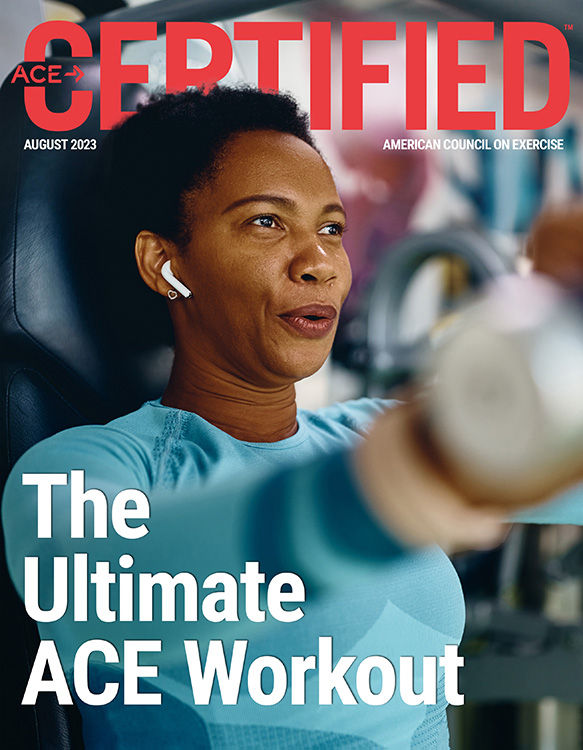The Ultimate ACE Workout: An Evidence-based Approach to Programming and Class Design

For more than two decades, ACE has supported research to evaluate the effectiveness of various exercises in targeting specific muscles or muscle groups. While ACE is committed to a personalized approach to exercise programming, as exemplified by the ACE Integrated Fitness Training® Model, it’s important for exercise professionals and health coaches to know which exercises activate muscles the most, as this can help you develop efficient and effective programs and classes.
The Ultimate ACE Workout features 10 exercises evaluated in various pieces of ACE-supported research over the years. Each exercise was selected because of its overall muscle activation for a specific body part. When combined, this total-body routine provides an evidence-based approach for developing muscular fitness.
To be clear, ACE is not promoting the workout as the best option for all clients or class participants. Instead, consider this a starting point from which you can modify, replace or add movements as needed to meet the needs and goals of each of your clients or participants. In addition, this workout may need to be modified based on equipment availability, group size, the fitness and ability levels of the exerciser(s) or countless other variables.
Stated simply, the workout presented below consists of those exercises revealed by ACE-supported research to yield the most intense contractions in the muscle or muscles being targeted. While this is not the only consideration when selecting exercises, it certainly should be among the deciding factors when choosing the movements to include in your limited time together with your clients or class participants.
Before diving into the workout, let’s look back at what each piece of ACE-supported research uncovered:
- Shoulder Exercises: Because the shoulder is such a complex joint that produces a wide variety of movement, exercisers are best served by doing the dumbbell shoulder press to target the front of the shoulders and either the 45-degree incline row or the seated rear lateral raise for the rear part of the shoulders. The researchers also recommend targeting the posterior deltoid first, because it’s typically the weakest of the shoulder muscles, then targeting the anterior deltoid.
- Chest Exercises: The researchers found that the barbell bench press, pec deck and cable crossovers can be used interchangeably or in combination.
- Back Exercises: The results of this study indicate that there isn’t one specific exercise that best activates all five muscles tested—middle trapezius, lower trapezius, latissimus dorsi, infraspinatus and erector spinae. That said, the bent-over row was identified by the researchers as the best option, with the I-Y-T raise a close second.
- Biceps Exercises: In this study, the concentration curl was shown to be significantly better at targeting the biceps than any of the other exercises tested.
- Triceps Exercises: This research found triangle push-ups to be the gold standard when it came to triceps exercises, with kickbacks and dips being solid alternatives.
- Abdominal Exercises: The bicycle maneuver and captain’s chair were identified as the top two exercises for strengthening both the rectus abdominis and the obliques.
- Hamstrings Exercises: Kettlebell swings, single-arm/single-leg Romanian deadlifts and prone leg curls can all be used interchangeably to target the biceps femoris and semitendinosus (note that the semimembranosus, the deepest of the three hamstrings muscles, was not evaluated because its location makes it impossible to monitor with surface electrodes).
- Glute Exercises: While quadruped hip extensions most effectively targeted both the gluteus maximus and medius, five other exercises were shown to be almost equally effective alternatives: squats, single-leg squats, step-ups, lunges and four-way hip extensions.
The Workout
To ensure your client is ready for the workout below, have them first complete a five- to 10-minute warm-up that begins with light activity, gradually increases in intensity and uses a variety of movements in all planes of motion. When finished with the workout, take them through a cool-down of approximately the same duration and intensity as the warm-up to initiate relaxation. The cool-down is also an ideal time for stretching.
Workout Instructions
This workout is designed to meet the recommendations for achieving general muscular fitness. The variables listed here (i.e., sets, repetitions, rest intervals and intensity) can be adjusted to meet other training goals.
- Each exercise should be performed for one to four sets of eight to 15 repetitions using 20 to 70% of the client’s one-repetition maximum.
- Have clients complete each exercise, in order, for one to four rounds. One round involves completing eight to 15 repetitions of all 10 exercises in order.
- Clients should rest for no more than 30 seconds between consecutive exercises and for two to three minutes between rounds.
- For exercises requiring repetitions on both sides of the body, have your client complete their target repetitions on both the right and left sides before moving on to the next exercise.
- This exercise program can be completed two days per week to meet the weekly recommendations for muscle-strengthening activity.
Exercises |
Other Programming Considerations
Exercise order is an important element to consider when taking an evidence-based approach to program design for those planning to do more than one type of training (e.g., cardiorespiratory, muscular, flexibility) within a single training session. ACE-supported research shows that exercise sequencing does matter and, while not set in stone, the results of this study should be taken into account alongside a person’s needs and goals when developing an exercise program or class.
When looking purely at physiological responses, cardiorespiratory exercise should be performed first, followed by muscular training and then flexibility training. A cardio-first approach allows for more accuracy in exercising at a programmed intensity. In other words, doing cardio first makes it easier to exercise within a target heart-rate range. In addition, performing muscular training after cardio maximizes the effectiveness of the muscular-training workout without increasing feelings of effort or like the workout is too exhausting to complete.
Recovery is another vital component of an exercise program. In fact, appropriate levels of recovery allow for optimal performance and continued progression via higher training volumes and intensities without the detrimental effects of overtraining. For this reason, recovery between sets, rounds and exercise sessions should be a planned part of an effective training program.
Consistently exercising is important for maintaining the adaptations gained through training. Stopping an exercise program for as little as one month is enough to diminish the training adaptations related to triglycerides, blood pressure and cholesterol levels. It is important to remember that bouts of activity of any duration contribute to the overall volume of physical activity and to the associated health benefits. In other words, every step, rep, set, hop, skip or jump counts, so be sure to help clients find ways to maintain their exercise programs and to break up sedentary time.
Final Thoughts
As a health and exercise professional, you know that countless variables must be considered when creating an exercise program or designing a group fitness class. The 10-exercise workout presented here is a great starting point, as incorporating these exercises (or appropriate and effective variations) can help ensure that your clients and class participants are getting a well-rounded, evidence-based workout that maximizes improvements in muscular fitness. Choosing appropriate exercises is an important task performed by personal trainers and group fitness instructors. Using an exercise evaluation framework for determining target muscles to be activated, potential risks, and exercise objectives can help you to evaluate the safety and effectiveness of your exercise program or class design. (Note: ACE Certified Professionals have exclusive access to a worksheet that makes it easy to evaluate and determine the appropriateness of a given exercise. This worksheet can be accessed via the button at the top of this page.)
In the video below, Michelle Leachman, ACE Professional Education Services Program Manager, talks about creating a group fitness class based on these exercises that she presented at the IDEA World 2023 convention. Due to limitations related to equipment availability, Michelle modified the “Ultimate ACE Workout” to be performed using kettlebells, dumbbells, a barbell and a platform, and offers suggestions for modifications if some pieces of equipment are not available.


